The 'New' Modern Workplace
Post by Simon Farthing |
I started writing this blog back in February. It was prompted by a discussion at the Conveyancing Association Annual Conference with clients and colleagues around how the modern workplace might look beyond 2020 as a result of innovation. February feels like a lifetime ago now and in terms of the ‘New’ Modern Workplace it might as well be, Covid-19 happened and the rules were changed.
Historically, the modern workplace was driven by economic and regulatory trends and advancing technologies promising productivity and efficiency gains. Organisations started investing in piecemeal digitalisation to deliver against increasing consumer requirement as and where it was mandated. Then came a global pandemic. Today, the modern workplace has a new meaning entirely. We are engaging with clients sat in our respective home offices/kitchens/lounges/sheds and using tools like the white board facility in Microsoft Teams to collaborate on complex projects – just as we did in face-to-face meetings, only a few weeks ago. And it feels completely normal!
The rapidly evolving nature of the global landscape makes one thing clear – innovation is no longer an event, but a ‘day factor’ occurrence and the modern workplace isn’t a static scenario. The modern workplace is a combination of incremental innovation, evolving culture and rapidly advancing technology – all of which is underpinned by digitalised data. Interestingly, regardless of organisations’ appetite for digital transformation, they are now well on this path of ‘no return’.
It has become abundantly clear during lockdown that most organisations already have some technology and tools in place to deal with this new way of working. In some cases, previously they were used sporadically, on a piecemeal basis as circumstances dictated. For others they met the needs of a specific few seen as the innovators, for others still there was no strategy to support their use. Lockdown forced a greater focus and businesses evolved. The reality is though there is more to be done and as the restrictions start to lift the attention needs to remain on how technology will help businesses recover and ultimately thrive in this new world.
Think about the experience that you create today for your clients; it might have worked during lockdown but there has been a degree of forgiveness and understanding about process. As we live the new normal the consumer will expect more. Clients will want to collaborate with you via the video tool of choice, share documents with you, chat and collaborate, they will expect their case to be handled even more efficiently, to be able to digitally sign their documents, receive automated updates, have an onboarding pack appear in the client portal within minutes of their instructions, rather than days. Overhead management will be even tighter and so the efficiencies will be expected to be even greater, process fat will have to reduce.
Lockdown has accelerated change for consumer but also for some suppliers, things that we have had in our roadmaps and engineering streams are more quickly getting into your hands because you need them. Now is the time to evaluate what you have available to you and set the strategy for what experience you want to create for your clients, your colleagues, your partners and your prospects.
Given the nature of global events, we can be in no doubt that the modern workplace is no longer a physical location and that it will continue to evolve. Technology already exists today, that can be leveraged to enable businesses to almost intuitively keep pace with the changing demands of all stakeholders – now is the time to engage with your strategic partners and shape your vision for the new modern workplace.

